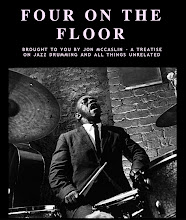PART ONE
The basic exercise that we'll start with is this:
*btw - I didn't come up with this basic one : )
(I'm going to credit Alan Dawson with this, although Chris McCann hipped this to me a number of years ago)
So then...
Play the ride cymbal rhythm with your right hand with the hihat on beats 2 & 4
Using the first pages of Stick Control divide the rhythms between your left hand on the snare drum and bass drum using this key:
R = Bass Drum
L = Snare Drum (left hand)
So what you get is a constant stream of swung eighth-notes between your left hand and bass drum underneath the steady ride cymbal and hihat. This in itself will take some careful and persistent practice to master, so take your time. Don't forget to keep the ride cymbal beat on top of the overall sound or else it can easily get buried underneath the constant rhythms of the snare and bass drum. And of course if it ain't swingin', it's not going to work and sort of defeats the purpose !
This is overall a very useful exercise to develop your Jazz independence skills. However, I don't think I've ever heard a serious Jazz drummer who's worth his mettle accompany a soloist with a constant stream of eighth notes between the snare and bass drum for measures and choruses on end !
Independence and coordination are of course important skills to have but one of the important keys to applying all this technical stuff in a musical situation is how you use......SPACE
So the following is my own variation of the above Stick Control Jazz independence exercise that takes the use of SPACE into acccount:
PART TWO
Instead of playing a constant steady stream of swung eighth notes, use these rhythmic cells instead:

Apply the sticking variations from Stick Control between the snare and bass drum using these cells and you'll develop a whole new vocabulary that is readily applicable to playing with other musicians.
For example:
Take the line of Stick Control that is LRLL RLRR (a single paradiddle starting on the left hand)
Voiced between the snare drum and bass drum (play with ride cymbal and hihat accompaniment - not notated here) this pattern would look like this:

Now apply that sticking with the various rhythmic cells as above. I'd suggest repeating each rhythmic cell several times to really get into the feel of each one (like 8 times each or so)
So here is LRLL RLRR broken up between the snare/bass drum using cell #1:

Ya' dig ?
You'll find that you can take a simple rhythmic cell or "motif" and use it in several different and practical ways.
See what other variations like this you can come up with on your own.
As Bob McLaren likes to say: "Just something to practice and keep you off the streets!"




















hey jon - your description of alan's exercise is correct in terms of mechanics, however alan would have students do that while singing a tune. he always wanted you to have the tune in your head when you were playing.
ReplyDelete